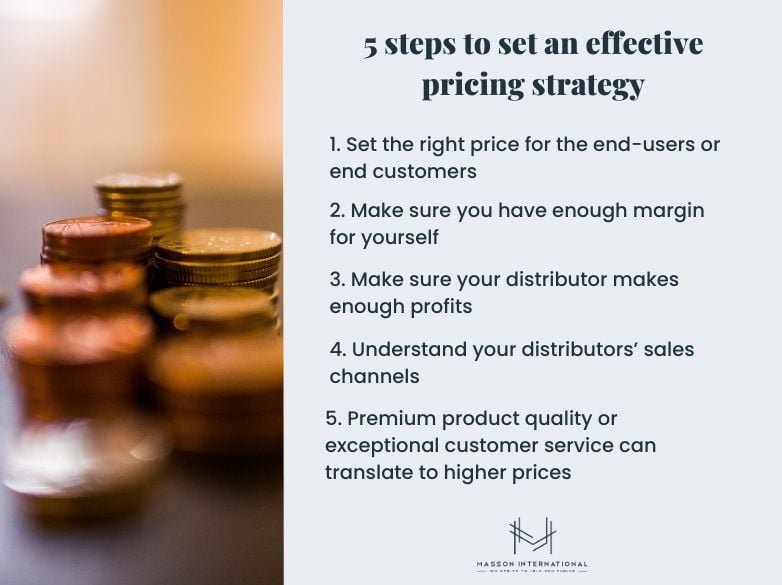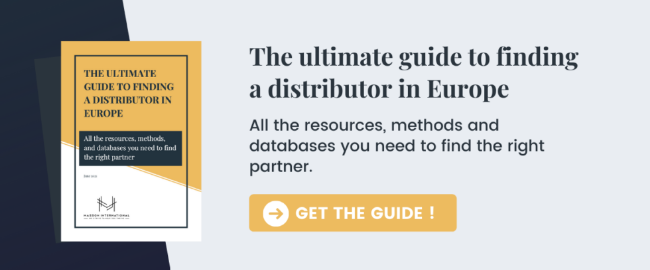Any company that has successfully ventured into foreign markets will likely agree on one thing: crafting a compelling distributor pricing strategy is not as easy as it sounds.
For a pricing strategy to truly work for both parties, it needs several things to snap into place. This short but informative blog post will show you how to create an effective distributor pricing strategy. We will also cover the common pitfalls to avoid so that you can lay the foundation for a long and fruitful relationship with your distributors.
The importance of having a good pricing strategy for distributors
A distributor is the manufacturer's first point of contact in a B2B supply chain, and the retail pricing for your product will largely depend on how much markup your distributors will add. Distributors usually add a percentage of the cost price as their markup, which covers their operating expenses and profit.
According to McKinsey & Company, pricing is one of the methods through which traditional distributors provide the most value to their customers. Demand-based pricing, competitive pricing, and value-based pricing have been favorites for several companies.
The average B2B distributor margin varies by industry, product category, and sales volume, but it typically ranges from 30% to 40%. And when you further add the average sales agent markup of 15-20%, it can raise retail prices by quite a few notches.
This is the key reason why pricing decisions matter so much when dealing with a distributor.
Setting the prices too high
Several distributors shy away from distributing products from manufacturers that charge more than their competitors’ prices in that product category. The reason is straightforward. They would have to set their prices too high if they agreed to high distribution prices. High prices mean they must work double time to convince retailers (middlemen) to stock their products or end clients to buy. In addition, overpriced retailers may be left with dead stock and full shelves. They may switch to a competitor’s product without sparing a second thought if they can set a higher distributor markup.
Hence, if your prices are too high, you may discourage distributors from carrying or promoting your product to their customers.
Setting the prices too low
Setting the prices too low may erode your margins and reduce your range of actions as a manufacturer. You also need to monitor how your distributors are setting their prices and whether they are following your suggested retail prices or not. You may also need to offer discounts, rebates, or incentives to encourage distributors to adhere to your pricing policies and goals, which it’ll be hard to do for you if your initial selling price to your distributor is too low.
But an effective distributor pricing strategy leaves everyone happy. It makes prices consistent across all levels, so everyone gets a good markup and healthy profit margins to flow back upstream in the supply chain. For the entire supply chain to succeed, everything must function together, beginning with the right distributor pricing strategy.
How to set an effective pricing strategy?
Setting a distribution pricing strategy that works for both you and your distributors requires careful planning and a good amount of forethought.
Here are five tips that will help you land the perfect distributor price:
1. Set the right price for the end-users or end customers
The end price that your target market would be willing to shell out on your product depends on three factors: your unique value proposition, the demand and supply in the market, and the prices of your rival products.
If your market price is too high, the market may prefer your competitor's products. If it's too low, you will leave a substantial margin, thus your profits, off the table or with your distributors. You want to avoid either of these outcomes.
But how do you find the right price for your product? There are a few ways you can achieve this:
- Take the time out to conduct online polls, surveys, and focus group interviews to find out how your target customers would react to different pricing.
- Also, look at how competing products are performing in different price brackets.
- If your product has low differentiation and high competition, you can use competition-based pricing to match or undercut the prices of your competitors and focus on efficiency and customer service.
- In addition to all of the above, you should also know how much it costs to work with a distributor and take these costs into consideration too.
2. Make sure you have enough margin for yourself
The difference between your market price and the cost of goods sold (COGS) should always be more than enough. Your COGS must include all the expenses that you had to incur, right from the costs of manufacturing your goods until they reach the customers' hands (production, overhead, distribution, marketing, etc.).
Having enough margin for yourself is important for future investments, such as buying new machines, hiring people, and conducting R&D on new products.
- To make sure you have enough margin for yourself, you have to add up all your direct and indirect costs. This will give you your real COGS.
- Find your breakeven point by dividing your fixed costs by your contribution margin (your market price minus variable costs). Now you will know how many units you need to sell to break even.
- You can then set a target margin that will allow you to achieve your desired profitability and growth.
- You can even enforce a "manufacturer-suggested retail price," or MSRP, on your distributors to ensure that the retail price doesn't fluctuate by an uncomfortable margin or that your distributors don't resort to dumping tactics to meet a sales number-based incentive or something similar.
3. Make sure your distributor makes enough profits
Distributors are the middlemen between you and your clients or your retailers. They need to make good money selling your products; otherwise, they may snap all ties with you. It's also possible that they will promote other brands and give your products the short end of the stick if their markup is too low.
The best way to keep your distributors happy and keep them coming back for more is by ensuring that they are making enough profit. You can start by understanding your distributors' costs and margins. This will help you set a realistic wholesale price that covers their costs and gives them a reasonable profit. Offering them discounts, incentives, or exclusivity deals to encourage them to sell more of your products also works well in the long run.
4. Understand your distributors’ sales channels before setting your price strategy
How your distributors sell your products and through which distribution channels hold significant sway over how you craft your distribution pricing strategy. Understand if your distributor sells directly to end users or through intermediary resellers. This will affect the price you need to set.
If your distributor sells directly to end users, you can set a higher price because there are no intermediaries taking a cut. But suppose there are intermediaries like a wholesaler or a retailer. In that case, each layer of intermediaries in the distribution channel implies a layer of margin on the end user price, and the price will be much higher than the price you sell to your distributor.
All the players in the distribution chain have to be on board with your price strategy, so they can generate enough profits from selling your products. You may need to be flexible with your pricing strategy to accommodate your distributors' sales channels. Otherwise, they may not be motivated to promote your products or try to undercut your prices by offering discounts or rebates.
5. Premium product quality or exceptional customer service can translate to higher prices
Can you develop customer experiences to increase prices and margins at reduced costs for you and the distributors?
Some customers are always game when buying a premium product and don't mind paying more for exceptional customer experiences. Tesla and Dyson are great examples of this. If you can think of ways to deliver premium customer experiences, you can charge high prices to end customers and let your distributors enjoy higher profit margins.
Even if you don't have a product that checks the boxes that make a product "premium,” you can still enrich your customers’ experiences by providing excellent customer and after-sales services. Free shipping, generous return policies, and an unlimited warranty on some parts and components are some ways you can justify a premium price with minimum effort.

Pitfalls to avoid when creating a distribution pricing strategy
If you want to create a mutually beneficial relationship with your distributor, there are a few mistakes you should avoid at all costs:
- Not being willing to concede to a few demands when negotiating with your distributors may hurt you badly. Offer them discounts, incentives, or even exclusivity whenever you can.
- Overpricing or underpricing your products can result in lost sales, reduced margins, or customer dissatisfaction. Overpricing can make you lose customers to cheaper alternatives, while underpricing can make you lose money or signal low quality or value.
- Not conducting enough market research to find out how much competitors are offering. Using competition-based pricing to provide distributors with a better deal also makes a good pricing strategy.
- Creating flat pricing strategies for all distributors, as pricing models with a cookie-cutter approach may not work for all.
- Being inflexible and resistant to change in response to market dynamics, customer feedback, and competitive pressures.
Ready to expand your business in Europe?
Contact Masson International today and let us help you find distributors in Europe. We will also help you with wider market access and expand your trade services.
Learn more about all the services we offer.







